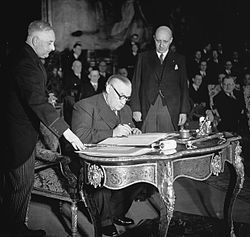Brysselfördraget
| Brysselfördraget | |
 Brysselfördraget undertecknas | |
| Typ | multilateralt avtal |
|---|---|
| Signerades | 17 mars 1948 |
| Plats | Bryssel, Belgien |
| Parter | 5 |
| Signerat av | Belgien, Frankrike, Luxemburg, Nederländerna och Storbritannien |
Brysselfördraget är ett fördrag som undertecknades den 17 mars 1948 av Belgien, Frankrike, Luxemburg, Nederländerna och Storbritannien. Överenskommelsen byggde på det tidigare Dunkirkfördraget från 1947 och var också vägledande för upprättandet av Atlantfördraget 1949.
Ändrade Brysselfördraget
Genom Atlantfördraget upprättades försvarsorganisationen Nato 1951, men en parallell utveckling ledde också till att det europeiska försvarssamarbetet i Västeuropeiska unionen inrättades genom Ändrade Brysselfördraget 1954. Det var de misslyckade förhandlingarna om att upprätta den mer omfattande Europeiska försvarsgemenskapen som ledde fram till Ändrade Brysselfördraget, vilket även fick anslutning av Grekland, Italien, Portugal, Spanien och Västtyskland.
Den 31 mars 2010 blev det klart att samtliga tio medlemsstater i Västeuropeiska unionen kollektivt avsåg att dra sig ur Ändrade Brysselfördraget.[1] Följaktligen upphörde VEU att existera den 30 juni 2011. I deklarationen från VEU:s ministerråd om att organisationen skulle upplösas framhölls att Nato fortsättningsvis utgör grunden för medlemsstaternas gemensamma försvar, men även det faktum att Europeiska unionen åtagit sig mer och mer av de uppgifter som tidigare åvilat VEU.[1]
Noter
- ^ [a b] Statement of the Presidency of the Permanent Council of the WEU on behalf of the High Contracting Parties to the Modified Brussels Treaty – Belgium, France, Germany, Greece, Italy, Luxembourg, The Netherlands, Portugal, Spain and the United Kingdom Arkiverad 10 oktober 2017 hämtat från the Wayback Machine., WEU 31 March 2010
| EU-portalen – temasidan för Europeiska unionen på svenskspråkiga Wikipedia. |
Media som används på denna webbplats
The Flag of Europe is the flag and emblem of the European Union (EU) and Council of Europe (CoE). It consists of a circle of 12 golden (yellow) stars on a blue background. It was created in 1955 by the CoE and adopted by the EU, then the European Communities, in the 1980s.
The CoE and EU are distinct in membership and nature. The CoE is a 47-member international organisation dealing with human rights and rule of law, while the EU is a quasi-federal union of 27 states focused on economic integration and political cooperation. Today, the flag is mostly associated with the latter.
It was the intention of the CoE that the flag should come to represent Europe as a whole, and since its adoption the membership of the CoE covers nearly the entire continent. This is why the EU adopted the same flag. The flag has been used to represent Europe in sporting events and as a pro-democracy banner outside the Union.Författare/Upphovsman: Noske, J.D. / Anefo, Licens: CC BY-SA 3.0 nl
Pact van Brussel. Bevin tekent

